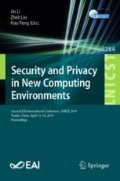Abstract
With the acceleration of the Internet of things (IoT) construction, the security and energy consumption of IoT will become an import factor restricting the overall development of the IoT. In order to reduce the energy consumption of the IoT heterogeneous perceptual network in the attack-defense process, the placement strategy of the intrusion detection system (IDS) described in this paper is to place the IDS on the cluster head nodes selected by the clustering algorithm called ULEACH, which we have proposed in this paper. Furthermore, by applying modified particle swarm optimization, the optimal defense strategy is obtained. Finally, the experiment results show that proposed strategy not only effectively detects multiple network attacks, but also reduces energy consumption.
Access this chapter
Tax calculation will be finalised at checkout
Purchases are for personal use only
References
Castiglione, A., Palmieri, F., Fiore, U.: Modeling energy-efficient secure communications in multi-mode wireless mobile devices. Comput. Syst. Sci. 81, 1464–1478 (2015)
Bhunia, S.: Internet of things security: are we paranoid enough. In: 2018 IEEE International Conference on Consumer Electronics (ICCE), p. 1. IEEE (2018)
Caviglione, L., Merlo, A.: The energy impact of security mechanisms in modern mobile devices. Netw. Secur. 2012(2), 11–14 (2012)
Hajisalem, V., Babaie, S.: A hybrid intrusion detection system based on ABC-AFS algorithm for misuse and anomaly detection. Comput. Netw. 136, 37–50 (2018)
Han, L., Zhou, M., Jia, W., Dalil, Z., Xu, X.: Intrusion detection model of wireless sensor networks based on game theory and an autoregressive model. Inf. Sci. 476, 491–504 (2018)
Heinzelman, W.R., Chandrakasan, A., Balakrishnan, H.: Energy-efficient communication protocol for wireless microsensor networks. In: Proceedings of the 33rd Annual Hawaii International Conference on IEEE, vol. 2, p. 10 (2000)
Henningsen, S., Dietzel, S., Scheuermann, B.: Misbehavior detection in industrial wireless networks: challenges and directions. Mobile Netw. Appl. 23(5), 1330–1336 (2018)
Hossein, J.: Designing an agent-based intrusion detection system for heterogeneous wireless sensor networks: robust, fault tolerant and dynamic reconfigurable. Int. J. Commun. Netw. Syst. Sci. 4, 523–543 (2011)
Luo, J., Wu, D.: Optimal energy strategy for node selection and data relay in WSN-based IoT. Mobile Netw. Appl. 20(2), 169–180 (2015)
Merlo, A., Migliardi, M., Caviglione, L.: A survey on energy-aware security mechanisms. Pervasive Mob. Comput. 24, 77–90 (2015). special Issue on Secure Ubiquitous Computing
Michael Quick, T.R.D.: The deter project. https://www.isi.deterlab.net/index.php3
Ozger, M., Cetinkaya, O., Akan, O.B.: Energy harvesting cognitive radio networking for IoT-enabled smart grid. Mobile Netw. Appl. 23(4), 956–966 (2018)
Sadek, R.A.: Hybrid energy aware clustered protocol for IoT heterogeneous network. Future Comput. Inform. J. 3(2), 166–177 (2018)
Sedjelmaci, H., Senouci, S.M., Taleb, T.: An accurate security game for low-resource IoT devices. IEEE Trans. Veh. Technol. 66(10), 9381–9393 (2017)
Sedjelmaci, H., Senouci, S.M., Feham, M.: New framework for a hierarchical intrusion detection mechanism in cluster-based wireless sensor networks. Secur. Commun. Netw. (2011)
Shi, Y., Eberhart, R.: A modified particle swarm optimizer. In: Proceedings of the IEEE Conference on Evolutionary Computation, pp. 69–73 (1998)
Acknowledgment
This paper is supported by National Natural Science Fund NSF: 61272033 & 61572222.
Author information
Authors and Affiliations
Corresponding author
Editor information
Editors and Affiliations
Rights and permissions
Copyright information
© 2019 ICST Institute for Computer Sciences, Social Informatics and Telecommunications Engineering
About this paper
Cite this paper
Zhou, M., Han, L., Lu, H., Fu, C. (2019). Intrusion Detection System for IoT Heterogeneous Perceptual Network Based on Game Theory. In: Li, J., Liu, Z., Peng, H. (eds) Security and Privacy in New Computing Environments. SPNCE 2019. Lecture Notes of the Institute for Computer Sciences, Social Informatics and Telecommunications Engineering, vol 284. Springer, Cham. https://doi.org/10.1007/978-3-030-21373-2_37
Download citation
DOI: https://doi.org/10.1007/978-3-030-21373-2_37
Published:
Publisher Name: Springer, Cham
Print ISBN: 978-3-030-21372-5
Online ISBN: 978-3-030-21373-2
eBook Packages: Computer ScienceComputer Science (R0)

